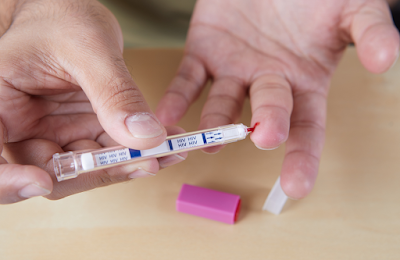By: Ranier Simons, ADAP Blog Guest Contributor
One of the most influential and basic tenets in the fight against HIV/AIDS is prevention. Testing is an integral tool for prevention. It is imperative to identify people living with HIV who are unaware of their status, which is globally estimated to be around six million people.[1] Testing stops individual disease progression by getting people into treatment and curbs the spread of HIV by informing individuals of their status in hopes of influencing behavior modification regardless of status. With the exception of the Washington, D.C. area, whereby decreased testing was actually associated with increased HIV diagnoses,[2] testing was adversely affected by the COVID-19 pandemic. National data shows that in healthcare and non-healthcare settings, there was a 43% and 50% drop in the number of the Centers for Disease Control & Prevention (CDC)-funded HIV tests administered.[3]
 |
| Photo Source: aidsmap |
According to the city’s Annual HIV, Hepatitis, Sexually Transmitted Infections (STIs), and Tuberculosis (T.B.) Surveillance Report released on February 7, 2023, there were 230 new HIV diagnoses in 2021, up from 219 in 2019.[2] About 1.8 percent of D.C. residents, 11,904, are living with HIV. The current new diagnosis numbers are much lower than the peak of 1,374 new cases in 2007, yet the upward trend is concerning.[2] The COVID-19 pandemic resulted in the closing of many healthcare facilities and changes in the capacity of remaining centers to deliver care. As a result, people did not seek out their regular preventive health visits and lost access to places that previously provided convenient testing. Kaiser Family Foundation reports that D.C. has the most HIV cases per capita and nearly three times the national rate compared to U.S. states.[2] This historical trend marks D.C. as one of the places the CDC watches closely. Thus, observing the increasing trend could shed light on trends that may be reported nationally as time goes on.
Washington, D.C. officials aim to reduce new infections to 130 per year by 2030, with a plan to have 95% of all people aware of their status, with 95% of diagnosed people on treatment, with 95% of those reaching undetectable viral suppression status.[2] HIV disproportionately affects Black residents, who comprise about 44 percent of the population of D.C. but almost 75 percent of HIV cases.[2] In response to this data, public health officials are looking into ways to reduce the stigma associated with prevention, testing, and treatment. Additionally, efforts to reduce socioeconomic barriers to HIV prevention are being explored.
Having stable housing is one crucial factor that contributes to improved health prevention. Stable housing enables people to have a home base to maintain their lives. Having a consistent place to stay makes it easier to maintain regular habits of antiretroviral treatment or PrEP. Stable housing also increases a sense of safety and community, giving people a support network. To examine the result of stable housing on the unhoused, in 2022, D.C. started a pilot program. The federally funded program paid for housing for one year for seven at-risk residents requiring them to set aside 30 percent of their income, undergo employment training, stay on PrEP, and participate in intensive case management.[2] The goal is to have all seven at a point where they can live independently. All seven have stayed in the apartment building and have maintained their PreP treatment.
 |
| Photo Source: aidsmap |
To further reduce barriers to testing caused by the pandemic, D.C. started a free at-home HIV and STD testing program in June 2020. D.C. residents can request an at-home testing kit, mail it in and see their results on a secure online portal. This is in addition to free walk-in testing available at any Labcorp patient service center, even if someone does not have insurance or their insurance does not cover lab testing.[4]
As people slowly begin to resume pre-pandemic levels of preventative care behaviors, medical professionals are predicting continued increases in HIV infection numbers. It is imperative that all jurisdictions nationally examine their populations with the same rigor as D.C. has done to curb increasing rates of HIV infection. D.C. is just a microcosm of the nation at large.
[1] Ong, J. J., Coulthard, K., Quinn, C., Tang, M. J., Huynh, T., Jamil, M. S., Baggaley, R., & Johnson, C. (2021). Risk-Based Screening Tools to Optimise HIV Testing Services: A Systematic Review. Current HIV/AIDS Reports, 19(2), 154-165. https://doi.org/10.1007/s11904-022-00601-5
[2] Portnoy, J. (2023, February 7). HIV diagnoses up slightly in D.C. after testing dipped during pandemic. Retrieved from https://www.washingtonpost.com/dc-md-va/2023/02/07/hiv-dc-pandemic-testing-disparities/
[3] CDC. (2022) HIV Testing Dropped Sharply Among Key Groups During First Year of COVID-19 Pandemic. Retrieved from https://www.cdc.gov/media/releases/2022/p0623-HIV-testing.html
[4] D.C. Health. (2022). Get Checked DC. Retrieved from https://www.getcheckeddc.org/
Disclaimer: Guest blogs do not necessarily reflect the views of the ADAP Advocacy Association, but rather they provide a neutral platform whereby the author serves to promote open, honest discussion about public health-related issues and updates.

No comments:
Post a Comment